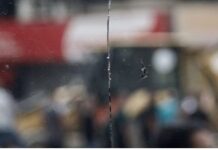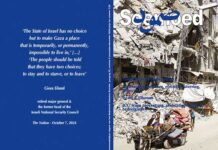Thaslima Begum
The Guardian / November 15, 2024
The 12-year-old is one of 2,500 children in Gaza that need to be evacuated urgently yet humanitarian agencies say few are being allowed to leave by the Israeli authorities
Cairo – It was the morning of 8 June when Ahmed Damoo got the call that his home, a small concrete building in the Nuseirat refugee camp in central Gaza, had been hit by an IDF rocket. When he returned to what was left of his house, he learned his family had been buried beneath the rubble.
One by one, his neighbours had dragged the bodies from the debris. Among the dead were Damoo’s in-laws and his two children, Hala, 13, and Mohannad, 10, who had been playing in the living room when they were killed. His wife, Areej, and toddler, Tala, had sustained serious injuries but were still alive.
Every day I watch my beautiful daughter, who can’t even bear to look at herself in the mirror – Ahmed Damoo
His last child, 12-year-old Mazyouna, could not be located. When Damoo eventually found her, he almost passed out.
“Her face was ripped off and her jaw was literally hanging,” he recalls. “My beautiful little girl was completely unrecognisable.”
At al-Aqsa hospital, doctors used what little resources they had to stitch Mazyouna’s face back together and hold the remaining structure in place.
Mohammed Tahir, a British doctor who is volunteering in Gaza, saw her during his ward rounds. “It was one of the most shocking cases I’ve seen,” he says. “Half of her cheek was missing and her bones were exposed.
“The doctors tried their best but the extensive reconstructive work she requires cannot be provided here in Gaza.”
Since June, the family and FAJR Scientific, a US non-profit organisation providing free medical care to Palestinians in Gaza and the West Bank, have tried to evacuate Mazyouna for treatment to the US, where they have surgeons waiting to treat her.
Five times their requests have been denied without explanation by the Israeli military body responsible for humanitarian affairs in Gaza, the Coordination of Government Activities in the Territories (COGAT).
Now, five months on, her situation is getting desperate. There is still shrapnel in her neck and she is in agony every time she moves. She cannot eat or speak. The platinum used by surgeons to rebuild her face is coming apart, with little more than a bandage holding her jaw together.
Doctors say her wounds are now infected and there is little they can do to stop it spreading. If she is not allowed access to surgery immediately, she could die.
“Every day I watch my beautiful daughter, who can’t even bear to look at herself in the mirror anymore,” says Damoo.
“The hardest thing for any parent is to watch their child suffer and not be able to do anything about it. I have already lost two of my children – losing another would destroy us completely.”
Mazyouna is one of an estimated 2,500 children in Gaza who UNICEF says need urgent medical attention and require immediate evacuation.
It’s is utterly shocking and outrageous that children who need essential treatment are being blocked by Israel from leaving Gaza – Moeen Mahmood, MSF
This week, the aid organisation Médecins Sans Frontières (MSF) said the Israeli government blocked, without explanation, the medical evacuation of eight children and their caretakers from Gaza who are in need of medical care, including a two-year-old with leg amputations, to the MSF hospital in Jordan.
It says that of the 32 children it has asked to be medically evacuated from Gaza to Jordan in recent months, only six have been allowed to leave.
“Lengthy procedures and unexplained denials block the provision of medical treatment for children who have been severely injured in Gaza,” says Moeen Mahmood, MSF’s country director in Jordan.
“It is utterly shocking and outrageous that children who need essential treatment are being blocked by Israel from leaving Gaza. Israel’s denial of urgent medical evacuations defies reason and humanity.”
UNICEF says children are being evacuated from Gaza at a rate of less than one child a day. Dr Tedros Adhanom Ghebreyesus, director general of the World Health Organization, says that since May, medical evacuations “have virtually ground to a halt”.
UNICEF’s James Elder says: “Children in Gaza are dying – not just from the bombs, bullets and shells that strike them – but because, even when miracles happen [and] the children survive, they are then prevented from leaving Gaza to receive the urgent care that would save their lives.
“This is not a logistical problem – we have the ability to safely transport these children out of Gaza. It is not a capacity problem – indeed, we were evacuating children at higher numbers just months ago. It is simply a problem that is being completely disregarded.”
Mazyouna’s parents were not given a reason for why their daughter has not been allowed to leave Gaza to get the help she needs. Other parents told the Guardian that they were also denied permission to travel with their sick children, saying that “security concerns” were cited, with no further clarification provided.
COGAT and the Israel Defense Forces (IDF) did not respond to requests for comment.
In many cases, humanitarian organisations say that when COGAT does approve children for evacuation, they turn down the requests of parents or relatives to travel with them.
“No one can say if these families will ever be reunited,” says Somaya Ouazzani, co-founder of the British medical aid organisation Children Not Numbers, which has so far helped evacuate more than 100 injured children from Gaza. “It is completely unacceptable that this situation should even exist.”
In a room inside a large military hospital about a 30-minute drive from central Cairo, 11-month-old Sadeel Hamdan lies curled up in a bed typically reserved for wounded soldiers. A series of tubes funnel into her tiny body while every few minutes, her slow breathing is punctuated by bleeps from a monitor.
“She just needs her mother,” says Tamer Hamdan, the baby’s father, who sits slouched in an armchair, exhausted. “No child in this situation should ever be without its mother.”
Born two months before the war in Gaza broke out, Sadeel was diagnosed with a chronic liver disease. As the war raged on and her condition worsened, a fluid buildup in Sadeel’s abdomen left her in agony and struggling to move or breathe.
Doctors warned that without an urgent liver transplant, she had only days to live. Her mother Huda’s application was rejected; she had been breastfeeding her baby until the day of her departure. Her father was only allowed to evacuate with her because he was her organ donor.
The war in Gaza has also created a generation of child amputees. UNICEF says that between last October and January, at least 1,000 children in Gaza lost one or both legs – equivalent to 10 children losing legs every day. That number has undoubtedly increased as the conflict enters its 14th month.
The Gaza war began in October 2023 after Hamas and Islamic Jihad militants massacred about 1,200 Israelis in coordinated incursions from the Gaza Strip and took 254 people hostage. Since then, about 43,000 Palestinians have been killed, mostly women and children, according to the health authorities in Gaza, while more than 80% of the population of 2.3 million have been displaced. Many of those being treated in hospitals are referred to as “WCNSFs” (wounded child, no surviving family).
For those children who are permitted to leave Gaza for treatment in another country, it is uncertain whether they will ever be able to return.
In El-Shorouk, near Cairo, Layan al-Atta sits in a wheelchair and looks out from a balcony window. Atta was wounded during an Israeli airstrike on a UN school in Deir al-Balah, where she had been sheltering with her family. She suffered a severe injury to her spinal cord and right leg, which later had to be amputated.
When Atta was evacuated to Egypt, her mother was granted permission but her father and siblings were left behind. “I didn’t just lose my leg, I lost my family and home,” she says “It feels like everything and everyone I love has been taken from me.”
Thaslima Begum is an award-winning journalist with a focus on women, conflict and human rights












